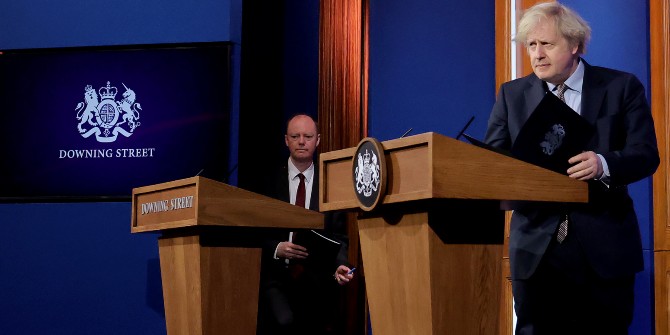During the pandemic, public procurement often had to be done at speed. A new ebook by Oriana Bandiera (LSE), Erica Bosio (World Bank) and Giancarlo Spagnolo (University of Rome II) looks at how a balance between rules and discretion can be maintained during emergency situations.
The procurement of public goods and services is a textbook example of moral hazard: an agent buys goods that he does not use, with money he does not own. The agent’s goal is typically set to achieve ‘value for money’ for the taxpayer, but value for money is hard to measure and often not entirely under the control of the agent. The latter makes the contract between the state and its procurement agents incomplete and, for economists, very interesting.
Our new ebook explores several aspects of the agency problems and the solutions that have been tried in a range of countries, with varying degrees of success. The core theme that runs through the book is the fundamental tension between rules and discretion. Rules limit the agent’s ability to pursue his private interests at the expense of the taxpayers, but discretion allows them to use their knowledge of the context and react quickly to unforeseen changes, as in emergencies. Two years into the pandemic, this is very topical and a number of chapters analyse how the tradeoff between rules and discretion changes during crises.
The trade-off between rules and discretion has been central to research on procurement. Steven Kelman (1990) stressed the costs of overly rigid regulations in US government procurement and made the case for increased discretion. Recently, research on the potential benefits of discretion has progressed rapidly. However, the risk of its abuse remains high, particularly during emergencies and with weak institutions.
In the textbook set up of the principal-agent model, there are just two actors. Reality is somewhat more complex, as the person in charge of enforcing rules is not the principal (the taxpayer) but rather another agent on a higher rung of the hierarchy who faces moral hazard problems of her own.
The procurement of public goods and services is a textbook example of moral hazard: an agent buys goods that he does not use, with money he does not own
To strike a balance between rules and discretion, we need to know more about the exact nature of the agency problem. A common assumption is that agents (and their monitors) are corrupt, that is, they actively exploit their position to extract rents. A less common assumption is that they have a strong preference for leisure and therefore put little effort in achieving their contractual objective of getting value for money. This distinction between corrupt and lazy agents is important because policies designed to curtail corruption such as strict rules that require extensive documentation can backfire if the agent is lazy – or even just cautious – as deviating from the rules is punishable even when doing so would benefit the taxpayer. Oriana Bandiera et al. (2009), for example, estimate excess expenditures on the procurement of generic goods in Italy, and show that about 20% can be attributed to corruption. This does not mean that corruption is not an issue; it means that inefficiency is the bigger issue.
The agency problem in the procurement of non-generics (for instance, roads) has a third actor – suppliers – who maximise their own utility and can collude with the agent to do so. This is particularly relevant in large infrastructure projects that are supplied by a limited number of firms which, by virtue of their market power and repeated interactions with the procurement office, can pursue their own private interest. The relevant question becomes who should choose the set of suppliers that can bid, and through what procedure.
We suggest that two steps can be taken to improve procurement outcomes and mitigate the risk of corruption, collusion, abuse and incompetence during crises.

The first step is better regulation of emergencies ex ante. Preparedness for emergency situations entails defining crisis-ready contracting procedures and outlining fundamental principles of crisis response. This should include developing public authorities’ competence and expertise, increasing capacity of the procurement workforce, and establishing reliable institutional structures to favour public contract adaptability to unanticipated shocks. Certain institutional arrangements – such as specialised emergency catalogues or framework agreements – can help. While procurement rules should be the main focus of this effort, other aspects of regulation – for example, rules on financial asset disclosures – play an important role as well.
The second step is increased monitoring to ensure that the increase in discretion coming during emergencies is not abused. Monitoring, however, is best reoriented towards outputs and results rather than procedural correctness. Audits and citizen oversight should be strengthened, including through the use of open data. Special attention should be paid to the design of auditing mechanisms.
Rules v discretion
The trade-off between rules and discretion is a topic of relevance beyond the study of public procurement. Increased discretion may of course increase the risk of its abuse, as Mihaly Fazekas, Shrey Nishchal and Tina Søreide show. After discussing a survey of aid-based procurement case studies from Italy, the authors focus on how regulations permitting simplified contracting of emergency goods introduced in Romania in March 2020 affected corruption risks in public procurement. In their analysis, they track a host of risk indicators such as the use of direct contracting or short advertisement periods, and also whether suppliers had tax haven registration or if they entered the market without healthcare experience. Following the regulatory change, the risks of corruption increased dramatically across all sectors of Romanian public procurement, despite the fact that the emergency rules only applied to the procurement of healthcare supplies. This has the policy implication that ringfencing emergency laws may be important, particularly in countries with low government capacity.
While emergencies justify a departure from standard procurement rules, implementation failures and rent-seeking opportunities remain substantial
The risks linked to discretion also increase sellers’ and buyers’ perception of corruption in procurement. Polina Detkova, Pavel Pronin, Andrey Tkachenko and Andrei Yakovlev study Russian procurement after a March 2020 regulatory change allowing direct procurement procedures without auction announcements for COVID-related purchases. They find that perceptions of buyers and suppliers about the presence of informal connections are comparable (56 percent versus 68 percent), but there is a significant difference in how market participants perceive their side in corrupt dealings. Twenty-five percent of buyers believe that there is corruption on the buyers’ side, while 76 percent of suppliers believe that suppliers are corrupt. This gap is dynamic – it was negligible before the pandemic and increased as it progressed.
Discretion during emergencies
In times of crisis and emergency, public procurement rules are often made more flexible to support governments’ efforts to increase spending, save lives and reduce the damage. This flexibility takes the form of a relaxation of rules requiring transparency, competition and oversight. It may include an increased use of negotiated contracts and direct contracting, more flexible pricing strategies, more frequent renegotiations, and accelerated timelines. This was the case during COVID.
While emergencies justify a departure from standard procurement rules, implementation failures and rent-seeking opportunities remain substantial. Emergency procurement has historically been linked to corruption, collusion and abuse. Examples of such corruption and abuse include the bunching of contracts below discretion-reducing thresholds; the allocation of contracts at inflated prices to the firms of family, friends and those who offer bribes; reduced quality; and increased allocation of contracts to politically connected firms.
This post represents the views of the authors and not those of the COVID-19 blog, nor LSE. It is an edited extract from Procurement in Focus: Rules, Discretion and Emergencies, a Centre for Economic Policy Research Press ebook, edited by Oriana Bandiera, Erica Bosio and Giancarlo Spagnolo.






1 Comments